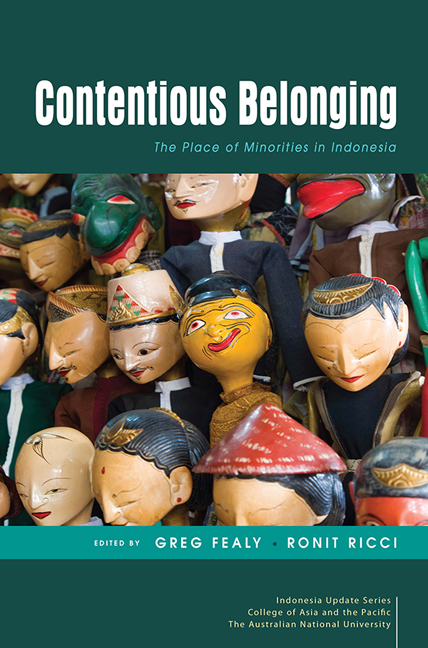Book contents
- Frontmatter
- Contents
- Tables and figures
- Contributors
- Acknowledgments
- Glossary
- Map
- 1 Diversity and its Discontents: an Overview of Minority–Majority Relations in Indonesia
- PART 1 HISTORY AND LAW
- PART 2 DISABILITY
- PART 3 SEXUALITY
- PART 4 RELIGION AND ETHNICITY
- PART 5 REFLECTIONS
- 14 Manipulating Minorities and Majorities: Reflections on ‘Contentious Belonging’
- Index
- Indonesia Update Series
14 - Manipulating Minorities and Majorities: Reflections on ‘Contentious Belonging’
from PART 5 - REFLECTIONS
Published online by Cambridge University Press: 06 September 2019
- Frontmatter
- Contents
- Tables and figures
- Contributors
- Acknowledgments
- Glossary
- Map
- 1 Diversity and its Discontents: an Overview of Minority–Majority Relations in Indonesia
- PART 1 HISTORY AND LAW
- PART 2 DISABILITY
- PART 3 SEXUALITY
- PART 4 RELIGION AND ETHNICITY
- PART 5 REFLECTIONS
- 14 Manipulating Minorities and Majorities: Reflections on ‘Contentious Belonging’
- Index
- Indonesia Update Series
Summary
The theme of this volume, ‘contentious belonging’, posits two possibilities: the inclusiveness that is expressed in the official national motto, Bhinneka Tunggal Ika, or ‘Unity in Diversity’, and the exclusiveness in the form of Muslim majoritarianism that generates pressure to conform to an increasingly conservative set of norms and values. The spectre of the latter as it affects religious and sexual minorities has been an important theme of the chapters in this book, but if we shift the focus away from the national to the local level, and we look at islands other than Java, then several other dimensions of minority status, also contentious, emerge. One is the tension between indigenous and migrant communities. Another is the transformation of ethnic minorities into majorities through pemekaran—a byproduct of decentralisation that has allowed the partitioning of administrative regions to create new provinces, districts and subdistricts. A third is racial identity, especially along Melanesian versus Malay lines.
MIGRATION
Any discussion of minorities and contentiousness cannot ignore migration. In many areas of Indonesia outside Java, the tensions are not primarily between Muslim and non-Muslim but between indigenous and migrant, and the line between the two is constantly changing. One can be from an ethnic majority at home (Javanese, Balinese, Madurese, Bugis), become part of a minority community as a migrant and then, through family networks, see one's ethnic group grow to the point of demographically and often economically displacing the indigenous population.
One example is the Butonese in West Ceram, Maluku province, who now constitute a majority in at least three subdistricts but who have no right to own land in those subdistricts owing to discriminatory local regulations. In one village, they actually constitute 90 per cent of the population but the indigenous lobby has had the village declared a customary village (desa adat) and the Butonese have been excluded from representation on the village council. At the same time, the redrawing of electoral districts in 2014 produced two out of five districts in which Butonese were the majority, enabling them to win seats in the regional parliament (Dewan Perwakilan Rakyat Daerah, DPRD) (Brauchler 2017).
- Type
- Chapter
- Information
- Contentious BelongingThe Place of Minorities in Indonesia, pp. 255 - 266Publisher: ISEAS–Yusof Ishak InstitutePrint publication year: 2019

